
Mantis shrimp, or stomatopods, are carnivorous marine crustaceans of the order Stomatopoda, branching from other members of the class Malacostraca around 340 million years ago. Mantis shrimps typically grow to around 10 cm (3.9 in) in length, while a few can reach up to 38 cm (15 in). A mantis shrimp's carapace covers only the rear part of the head and the first four segments of the thorax. Varieties range in colour from shades of brown to vivid colours, with more than 450 species of mantis shrimp being known. They are among the most important predators in many shallow, tropical and subtropical marine habitats. However, despite being common, they are poorly understood, as many species spend most of their lives tucked away in burrows and holes.

Mantidae is one of the largest families in the order of praying mantises, based on the type species Mantis religiosa; however, most genera are tropical or subtropical. Historically, this was the only family in the order, and many references still use the term "mantid" to refer to any mantis. Technically, however, "mantid" refers only to members of the family Mantidae, and not the 14 remaining families of mantises. Some of the most recent classifications have promoted a number of the mantid subfamilies to the rank of family, e.g. Iridopterygidae, Sibyllidae, Tarachodidae, Thespidae, and Toxoderidae, while other classifications have reduced the number of subfamilies without elevating to higher rank.
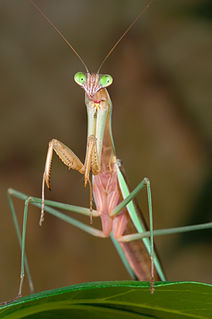
Tenodera is a genus of mantis in the family Mantidae which contains several species of praying mantises. The species in this genus can be found primarily in Africa, Asia and Australia, but also North America.

Flower mantises are those species of praying mantises that mimic flowers. Their coloration is an example of aggressive mimicry, a form of camouflage in which a predator's colours and patterns lure prey. The flower mantises are not a natural group with a single ancestor, but most of the species are in the family Hymenopodidae. Their behaviours vary, but typically involve climbing a plant, and then staying still until a prey insect comes within range. Many species of flower mantises are popular as pets.
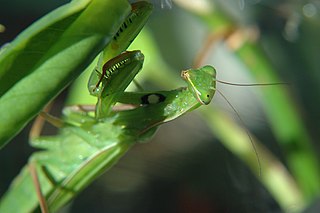
The genus Mantis is in the family Mantidae, of the mantis order Mantodea.

Archimantis latistyla, commonly known as the large brown mantis is a species of mantid native to Australia. The large brown mantis has two subspecies, a widespread subspecies and the stick mantis ghost from Bundabergs Turtle Sands. The stick mantis ghosts are not as aggressive as the widespread species but have a defense display used to make the mantis appear larger by flinging its front legs into the air and putting its head down along with its antennae. Large brown mantids are light brown with short winged female and a long winged male. The subspecies from Bundaberg is a pale cream white with a yellow and black eye in between the arms. The large brown mantis female is short winged - her wings reach only half her abdomen and she is not able to fly—but the long winged male has wings that cover the entire abdomen. They have two pairs of wings - the top pair are the wing covers and the bottom wings enable the mantis to fly.

The false garden mantis is a species of praying mantis in the family Mantidae. It is one of the most common species of mantis in Australia. Females reach 70 mm while males reach 50 mm.
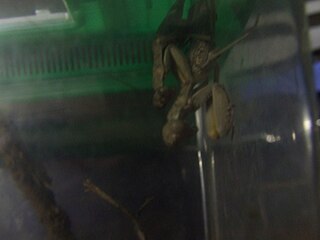
The burying mantis is a species of mantid native to Australia. They are white or brown and can reach lengths of up to some 40mm long, with distinct markings on the thorax and with a white blotch on the wings. They're called burying mantids because females dig holes in the ground, in which they lay their eggs and then refill the holes.

Orthodera ministralis, common name garden mantis or Australian green mantis, is a species of praying mantis from Australia. The garden mantis inhabits the whole of Australia, and can often be found hidden in leafy scrub from ground to eye level. It feeds on small insects by ambushing them.

Mantis octospilota, common name eight-spotted mantis or blackbarred mantis, is a species of praying mantis found in Australia. As its common name suggests, it is primarily identified by the eight black spots along the dorsal surface of its abdomen.
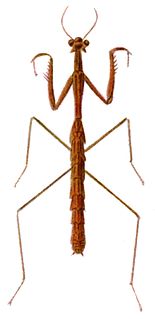
Stick mantis and twig mantis are common names applied to numerous species of mantis that mimic sticks or twigs as camouflage. Often the name serves to identify entire genera such as is the case with:

Orthodera novaezealandiae, known as the New Zealand mantis or the New Zealand praying mantis, is a species of praying mantis which is, as both the scientific name and common names suggest, indigenous and endemic to New Zealand.

Bolbe is a genus of praying mantises, sometimes called by the common name ground mantis, that are found in Australia.

Bolbe pygmaea is a species of praying mantis in the family Nanomantidae. It is endemic to Australia.
Gyromantis occidentalis, commonly known as the eastern bark mantis, is a species of mantis found in Australia.
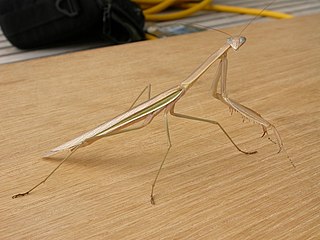
Tenodera australasiae, the purple-winged mantis, is species of praying mantis. Found in Australia, it is common in most parts of Brisbane (QLD). Both males and females are capable of flight. The species has not been shown to be parthenogenetic.
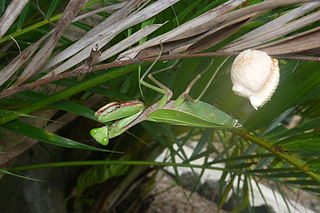
Hierodula majuscula is a species of praying mantis in the genus Hierodula. It is also known as the giant rainforest mantis and the Australian giant mantis. It is found in coastal northern Australia, usually in rainforest and adjacent habitats. This species is typically green although a less common bright yellow form does occur.

Mantises are an order (Mantodea) of insects that contains over 2,400 species in about 460 genera in 33 families. The largest family is the Mantidae ("mantids"). Mantises are distributed worldwide in temperate and tropical habitats. They have triangular heads with bulging eyes supported on flexible necks. Their elongated bodies may or may not have wings, but all Mantodea have forelegs that are greatly enlarged and adapted for catching and gripping prey; their upright posture, while remaining stationary with forearms folded, has led to the common name praying mantis.

Orthodera is a genus of praying mantises that can be found in Australia and Southeast Asia, with one species said to be the only native species of mantis of New Zealand.














